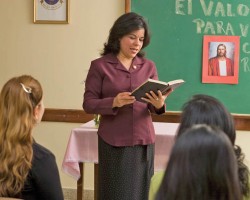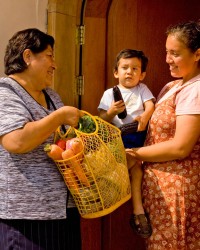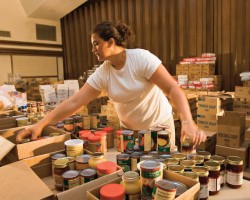By Keith Lionel Brown
Church services in the Church of Jesus Christ of Latter-day Saints (sometimes inadvertently referred to as the “Mormon Church” in the media) are divided into three segments. The first and most important segment is Sacrament meeting, where members meet together to partake of the sacrament of the Lord’s supper and hear talks given by various members of the congregation. The second segment is Sunday School. During the third segment, members split into various groups and attend separate meetings: Priesthood Meeting for the men, Relief Society for the women, and Young Men/Young Women meetings for the youth. “Primary”activities and classes are provided for children 18 months to 12 years of age during both the second and third segments.
Mormon Women As Leaders and Teachers
Women are equal participants as teachers and leaders in every one of these church programs except for Priesthood Meeting. Along with the men, they pray and speak in Sacrament Meetings, conduct music, provide piano and organ prelude and accompaniment, and participate in choir and music programs. Similarly, both women and men teach and lead Sunday school classes. Women alone preside over the Primary program, although both men and women teach Primary classes. Women are the teachers and leaders of the Young Women, while men teach and lead the young men. Most importantly, however, the women of the church lead, teach, and comprise the Relief Society – their exclusive domain.
What is the Relief Society?
The Prophet Joseph Smith, the founding prophet of Mormonism, organized the Relief Society on March 17, 1842. A group of women had met together, desiring to assist the poor and suffering in the community, and had come to the prophet so that they might be organized under priesthood authority. Joseph Smith taught that the Relief Society was organized for “the relief of the poor, the destitute, the widow and the orphan, and for the exercise of all benevolent purposes” (Teachings of Presidents of the Church: Joseph Smith [2007], 452). In addition, he taught that the Relief Society was “not only to relieve the poor, but to save souls” (Teachings: Joseph Smith, 453). Thus the Relief Society, which is by now one of the oldest and largest women’s organizations in the world, was born.
The Work of the Relief Society
In the Handbook of Instructions (Book 2) for the Church of Jesus Christ of Latter-day Saints, it states that the purpose of the Relief Society today is to prepare women for “the blessings of eternal life by helping them increase their faith and personal righteousness, strengthen families and homes, and help those in need.” These purposes are accomplished in various ways. Mormon women teach and learn the gospel from one another in Sunday Relief Society meetings and other Relief Society meetings and activities. Weekday activities focus on additional ways to strengthen families. Humanitarian projects are regularly organized. And Visiting Teachers make sure that the Relief Society is aware of any special needs in the congregation, and that those needs are met.
Visiting Teaching
Visiting Teaching is a Relief Society program where each woman in the Mormon congregation is watched over and visited regularly by a pair of Relief Society members. Visiting Teachers care for, remember, strengthen, and teach the women to whom they are assigned. The women of Relief Society refer to one another as “sisters,” and try to fulfill that role for one another. Visiting Teachers are aware of any special needs the sisters and families they visit might have from time to time, and call upon the resources of the Relief Society as needed. Each woman in Relief Society has a pair of Visiting Teachers, and most are also Visiting Teachers themselves. In this way, each sister’s physical needs are met, as well as providing the opportunity for friendship, support, and spiritual instruction.
Humanitarian Work
Welfare and compassionate service are central to the work of the Mormon Relief Society. In addition to caring for one another, Mormon women are heavily involved in organizing and producing goods for the humanitarian arm of The Church of Jesus Christ of Latter-day Saints. The motto of the Relief Society is ” never faileth.” It comes from the scripture found in 1 Corinthians 13:8, which reads:
Charity never faileth: but whether there be prophecies, they shall fail; whether there be tongues, they shall cease; whether there be knowledge, it shall vanish away.
gThe Church of Jesus Christ of Latter-day Saints has an effective welfare system in place to provide for the needs of members who are experiencing financial difficulties. Mormons throughout the world also contribute goods and services to the humanitarian efforts of the church, which provide for people throughout the world who are suffering from poverty, illness, or natural disaster. Mormon women, members of the Relief Society, are key in organizing and producing whatever is needed.
Becoming a Member of the Relief Society
All adult women in the Church are members of the Relief Society. Normally a young woman advances into Relief Society sometime during the year following her 18th birthday. By age 19, most young woman are fully participating in Relief Society. The leaders of Young Women and Relief Society work closely together to ensure that a young woman’s transition into Relief Society is successful.
Adult women who serve in other auxiliaries of the Church such as Primary, Young Women, or other callings that prevent them from attending Sunday Relief Society meetings continue to participate in Relief Society. They are assigned Visiting Teachers, and they themselves serve as Visiting Teachers. In addition, they may be given assignments to serve others and to teach classes at other Relief Society meetings, provided that such assignments do not pose any undue burdens on them.
As Sisters in Zion
As Sisters in Zion, Mormon women join hearts and hands to minister not only to members of the Church, but also to non-members whom they have contact with. Membersof the Relief Society serve, following Paul’s admonition:
Wherefore lift up the hands which hang down, and the feeble knees (Hebrews 12:12).
Women of other faiths and denominations who visit and attend Mormon Relief Society are welcomed with open arms and are encouraged to be active participants. Come and join in as Sisters in Zion!
Keith L. Brown is a convert to The Church of Jesus Christ of Latter-day Saints and serves as the Ward Mission Leader in the Annapolis, Maryland Ward.
Daughters in My Kingdom: The History and Work of Relief Society



